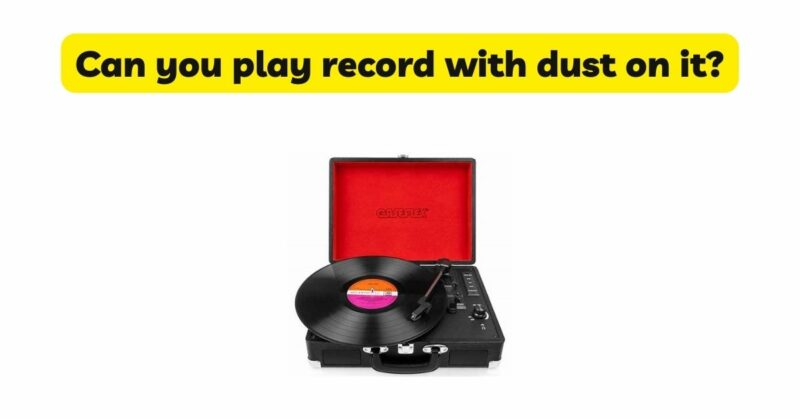Vinyl records have made a remarkable resurgence in recent years, captivating audiophiles and music enthusiasts with their warm, nostalgic sound. As more people delve into the world of vinyl, questions surrounding record maintenance and playback arise. One such query is whether you can play a record with dust on it. In this article, we will delve into the intricacies of vinyl record care, exploring the impact of dust on playback quality and uncovering the proper techniques for maintaining and cleaning vinyl records.
- The Vinyl Record: A Timeless Medium
Before we explore the impact of dust on vinyl records, it is essential to understand the structure and composition of these fascinating audio artifacts. Vinyl records are analog audio discs that have a series of grooves engraved onto them, containing the sound’s analog waveform. When a stylus, or needle, passes through these grooves, it translates the physical vibrations into electrical signals, which are then amplified and played through speakers, producing the audible sound we hear.
- The Detrimental Effects of Dust on Playback Quality
Dust, an ever-present intruder, can significantly affect the playback quality of vinyl records. When dust settles into the grooves of a record, it obstructs the stylus from making direct contact with the vinyl surface. Consequently, this interference causes pops, crackles, and distortion, compromising the clarity and fidelity of the music.
Moreover, the buildup of dust on the stylus itself can lead to premature wear and tear. The abrasive nature of dust particles can grind against the stylus, causing it to degrade faster and even damage the grooves on the records. Therefore, maintaining a clean record surface and stylus is crucial for preserving the longevity of your vinyl collection and ensuring optimal playback quality.
- Proper Vinyl Record Maintenance
To maximize the lifespan of your vinyl records and ensure an enjoyable listening experience, adopting proper record maintenance practices is essential. Here are some effective methods to keep your records dust-free and in pristine condition:
a. Store Records Vertically: Storing records vertically, like books on a shelf, helps prevent dust from accumulating on their surfaces. Avoid stacking records horizontally, as this can lead to friction and the transfer of dust particles between records.
b. Invest in Inner Sleeves: Inner sleeves act as a protective barrier between the vinyl surface and the outer jacket. High-quality anti-static inner sleeves reduce static electricity, minimizing the attraction of dust particles to the records.
c. Clean Hands Before Handling: Before handling records, make sure to wash your hands thoroughly to avoid transferring oils and dirt onto the vinyl surface.
d. Use a Carbon Fiber Brush: A carbon fiber brush is an excellent tool for regular maintenance. Gently brushing the surface of the record with this anti-static brush can remove surface dust without causing any damage.
e. Avoid Touching the Grooves: Handle records by the edges or label area to avoid touching the grooves, as oils from your fingers can be difficult to remove and may attract dust.
- Record Cleaning: Manual vs. Automatic Methods
While routine maintenance with a carbon fiber brush is helpful, occasionally, vinyl records may require a deeper cleaning. Various cleaning methods exist, ranging from manual to automatic approaches:
a. Manual Cleaning: Manual cleaning involves using specialized record cleaning solutions, microfiber cloths, and cleaning brushes to remove stubborn dirt and grime. This method requires patience and precision but can yield excellent results.
b. Record Cleaning Machines: For those with extensive vinyl collections, investing in a record cleaning machine can be beneficial. These machines use a combination of gentle brushes and cleaning solutions to deep clean records, effectively removing stubborn contaminants.
c. Ultrasonic Cleaning: Ultrasonic record cleaning is a more advanced technique that employs ultrasonic waves to dislodge and remove dirt particles from the grooves. Although costly, this method offers unparalleled cleanliness and preservation.
- The Importance of a Clean Stylus
In addition to maintaining clean records, ensuring that your stylus remains free from dust and debris is crucial. A dirty stylus can transfer contaminants onto the record surface, impairing playback quality and potentially damaging both the stylus and the grooves. Regular stylus cleaning with a stylus brush or a specialized cleaning solution is essential for optimal playback and longevity.
Conclusion
In the realm of vinyl record playback, dust can pose a significant obstacle, hindering sound quality and impeding the overall enjoyment of your collection. To preserve the integrity of your records and enhance your listening experience, adopting proper maintenance techniques is paramount. By implementing regular cleaning routines, storing records correctly, and maintaining a clean stylus, you can minimize the impact of dust and relish the full potential of vinyl’s rich and immersive sound.


